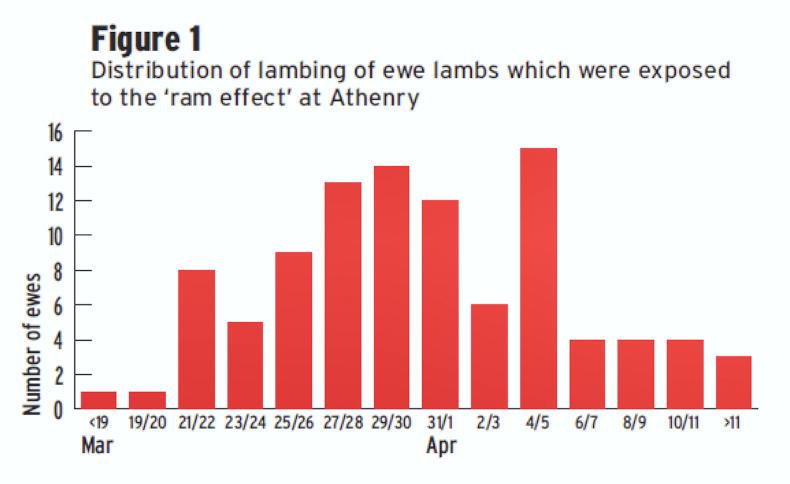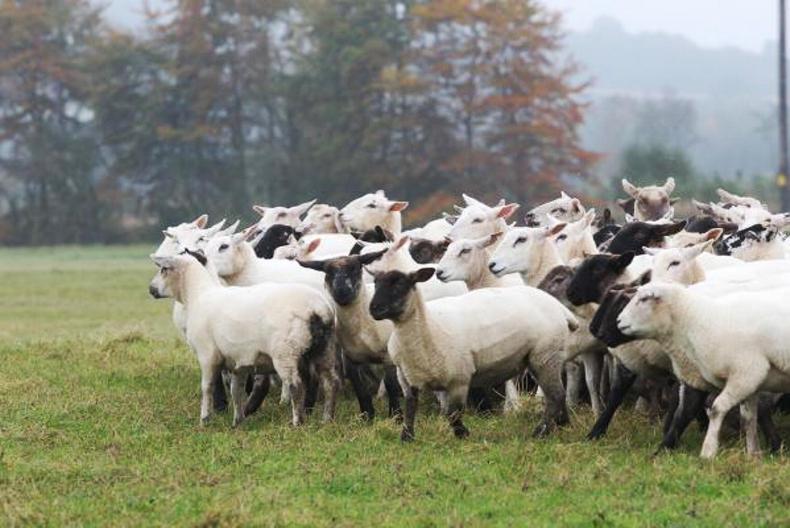Breeding ewe lambs, provided that they are managed to meet their nutritional requirements, reduces the cost of rearing replacements and increases flock output and profitability.
Other reasons for breeding ewe lambs include increasing lamb carcase output during the ewe’s lifetime, and thus overall efficiency, and speeding up genetic gain due to a reduction in the average generation interval.
Finally, ewes that lamb as one-year-olds are better mothers at the two-year-old lambing than when lambing for the first time as two-year-olds.
My objective in this article is to discuss mating management of ewe lambs. In a subsequent article, the performance of ewe lambs and their progeny, as influenced by ewe genotype, will be discussed.
Athenry study
A major study was initiated last year at Athenry with the objective of evaluating the effects of age at first lambing (one or two years) and ewe genotype (Suffolk, Suffolk x Belclare, purebred Belclare) on the lifetime performance of ewes.
This study will last until the ewes are culled for natural reasons. The different ewe genotypes were included in this study to determine the effect of prolificacy on age at culling, replacement rate and lifetime output.
Puberty
Many factors influence the time at which ewe lambs reach puberty and thus when they are available for mating.
Results from previous studies have shown that the major factors influencing puberty are age, liveweight and breed. Most ewe lambs reach puberty at a liveweight of between 35kg to 45kg, but this is also influenced by age and breed.
For example, a breed of ewe lamb which reaches puberty in October at 40kg will reach puberty at a lighter weight later in the season.
Liveweight is the major factor influencing the age at puberty and also affects potential litter size.
As a general rule, to ensure that a high proportion of ewe lambs reach puberty before the end of the joining period, ewe lambs should be approximately 60% of mature liveweight at joining.
For example, the mature liveweight of Suffolk and Belclare breeds are 83kg and 77kg; therefore 60% of mature liveweight is 50kg and 46kg, respectively.
Mating management
The date of first oestrus in ewe lambs is normally later than the date of onset of the breeding season in adult ewes.
Evidence suggests that it would take a 35-day joining period for first mating to be recorded for 90% of a ewe lamb flock.
As ewe lambs have a lower pregnancy rate per oestrus than mature ewes, approximately only 70% of the animals would be pregnant after a 35-day joining period.
There are two options to increase pregnancy rate. The first is to increase the length of the joining period, which may not be advantageous as it prolongs the lambing season and is also likely to result in a lot of store lambs next autumn. The second option is to synchronise the timing of first oestrus in the ewe lambs using the ‘ram effect’.
Ram effect
The ‘ram effect’ can be used to induce ewes (ewe lambs or adult ewes) to start cycling provided they are sufficiently close to the time of onset of normal cyclicity.
This will also compact both the mating season and the subsequent lambing season. The ‘ram effect’ is due to the impact of pheromones released by sexually mature rams on ewes that are not yet cycling. An apron can be used on the ram to prevent mating if any ewe is already cycling.
For the ram effect to work, the ewes should have not been in contact (either sight or smell) with rams for the previous month.

When such ewes are exposed to rams, the rams’ pheromones cause hormonal changes in the ewe that initiate cyclicity. The ram effect is illustrated in Table 1.
Upon introduction of adult rams, most ewes that are not already cycling will have a ‘silent heat’ within 36 hours and a proportion will have a second silent heat after six days.
These ‘silent heats’ are not detected by rams. The rams should be removed after 24 to 36 hours. Ewes will cycle at approximately 17 days after the final silent heat.
Consequently there are two peak times for the number of ewes showing heat, namely 18 and 23 days after exposure to the rams.
Consequently fertile rams should be introduced to the flock 14 days after the rams used to induce the ‘ram effect’ were introduced; the peak mating times will be four and nine days later. The reason the rams are introduced at day 14 is to allow for short cycles and to pick up any individuals that were already cyclic at the time of ram introduction.
Last year at Athenry the ‘ram effect’ was used on the ewe lamb flock. The effect on lambing spread is presented in Figure 1.

All ewe lambs were mated during the breeding season and the lambing season was compact with 75% and 90% lambing within two and three weeks, respectively. This clearly illustrates that the ram effect synchronises lambing.
When using the ram effect to synchronise the mating season, it is essential to have an adequate number of rams for mating (one ram per about 18 to 20 ewes).
It is also essential to have adequate facilities, especially lambing pens (one pen per six ewes) and labour, to cope with the flock during the lambing season.
Ideally, ewe lambs should be mated so that they lamb during the second half of the lambing period of the adult flock to facilitate cross fostering and also to avoid an extended lambing season.
Ewe lambs should be mated in a separate flock from mature ewes. Why? Ewe lambs are less likely than mature ewes to seek the ram when in heat and have a shorter oestrus. Consequently there could be a high barren rate if ewe lambs have to compete with adult ewes for the attention of the rams.
Mating ewe lambs provides an opportunity to increase flock profitability.
Ensure lambs are approximately 60% of mature weight at joining. Minimum weight should be 50% of mature weight. For Suffolk cross and Belclare cross lambs 50% mature weight is 41.5kg and 38.5kg whilst 60% mature weight is 50kg and 46kg, respectively.
Use of the ‘ram effect’ can induce cyclicity and compacts mating, and subsequently compacts the lambing season.
This article was first published in October 2013.






 This is a subscriber-only article
This is a subscriber-only article










SHARING OPTIONS: